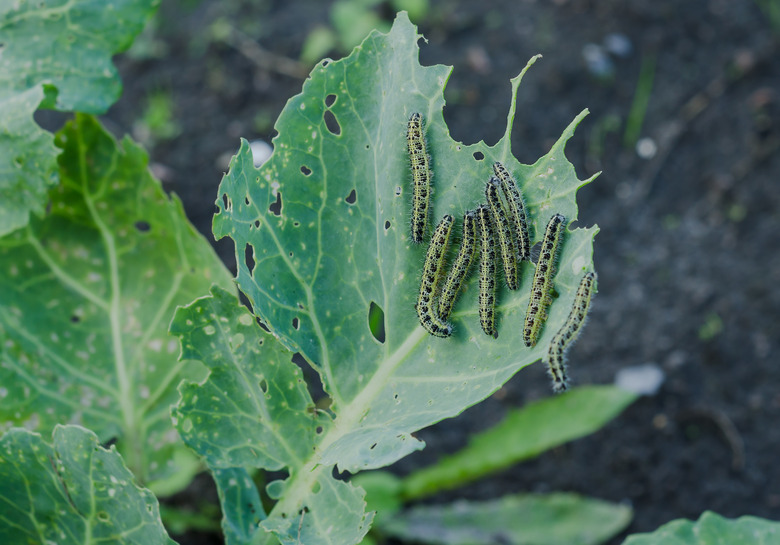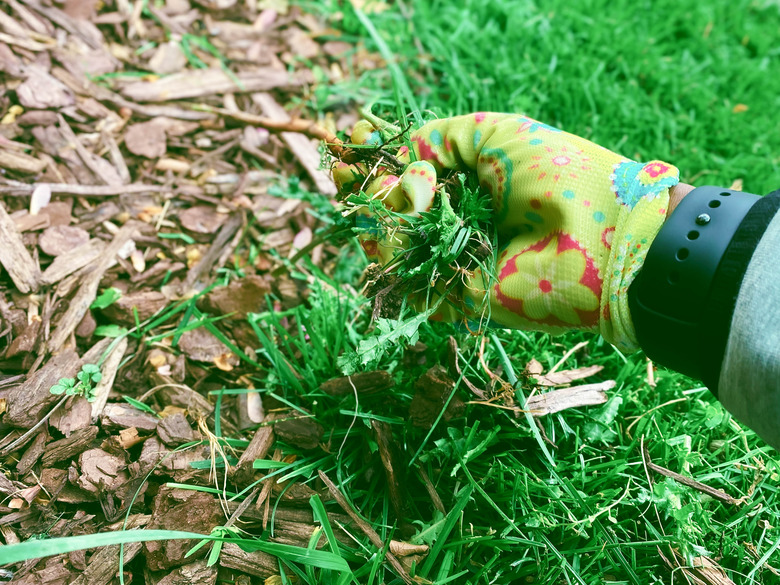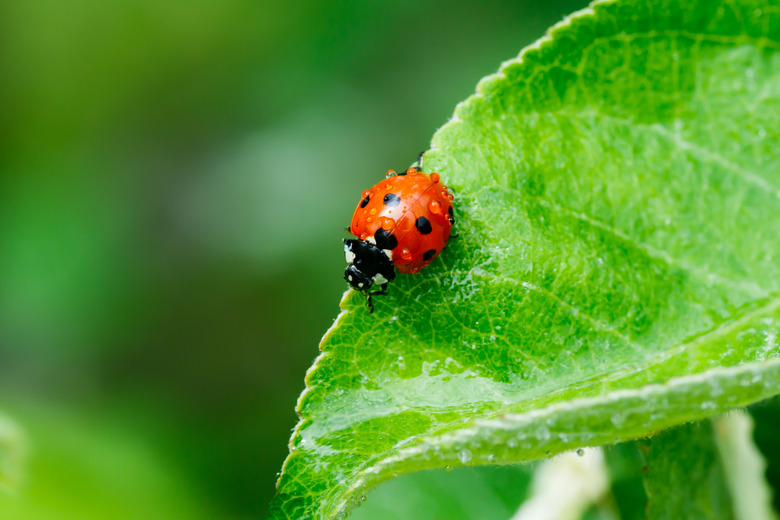A Beginner's Guide To Managing Garden Pests
We may receive a commission on purchases made from links.
Don't make it a New Year's resolution to eliminate garden pests in your backyard. It's not going to happen! Insects are found in every garden — some extremely beneficial, some destructive or annoying. Learning to manage insect pests is part of the gardening experience.
That doesn't mean you have to stand by helplessly as insects chomp through your veggies, however. What it does mean is that it's important to get an overview of pest management, including the ways you can keep your plants strong enough to fight off pests. To manage the remaining pests, you can opt for organic pest control and integrated pest management (IPM) depending on how strongly you feel about chemical pesticides.
Pests in the Garden
Pests in the Garden
Insect pests are an inevitable part of any garden. Most bugs live in soil or on or near plants, and soil and plants are the core of your garden. That's a good thing since beneficial insects help aerate the soil and pollinate your crops. Some even eat harmful pests for lunch.
Not all insects are helpful to a gardener. Some are destructive garden pests, and it's natural to want to reduce their numbers. Fortunately, there are more than a few things you can do to prevent a hostile takeover of your tomato bed or blueberry patch, including steps to keep your plants strong and healthy. Improving your garden soil, keeping your garden tidy, and making sure the plants you install don't carry common garden pests themselves are great first steps for pest control.
Healthy Garden Soil
Healthy Garden Soil
Keeping your garden soil healthy can go a long way toward reducing garden pests. That's because plants that grow in nutrient-rich soil develop a strong immune system that can fight off insect pests, and healthy soils feed and shelter beneficial soil life.
Healthy garden beds are those with plenty of organic material blended into the soil. This is easy to achieve and inexpensive if you start your own compost pile in the backyard. That way, you can turn kitchen scraps and garden detritus into rich, organic compost for free.
Adding organic matter to the soil also helps the soil hold moisture. This can be accomplished by adding compost to the soil or layering organic mulch on top of the soil. Organic mulch has the added benefits of stabilizing the soil temperature and holding down weeds.
Clean and Tidy Garden
Clean and Tidy Garden
Weeds and garden debris not only make your garden look less appealing but they also encourage critters. That's why an important step in managing garden pests is to keep the planting beds and the area around them clean and tidy. All you need is a garden rake, a shovel, and sturdy debris bags.
Many types of insect pests spend the winter in or on weeds or under detritus in or near the garden beds. Some lay their eggs there, and in the springtime, hungry larvae emerge and attack your young veggies. Take the time to pull out weeds by the roots and remove all debris, like fallen leaves and dead plants. Bugs can also hide in compost if it's spread on top of the soil as well as under mulching material. Make it a point to work the compost into the soil instead of leaving it on top and look under the mulch from time to time, scouting for earwigs, slugs, snails, and millipedes. Organic mulch can be worked into the soil at the end of the season.
Healthy Garden Transplants
Healthy Garden Transplants
You'd be surprised at how many times gardeners introduce pests into their own gardens by taking a casual attitude toward choosing transplants. Lots of insect pests catch rides into the garden in the soil or on the leaves of infected plant starts.
Selecting strong, healthy plants from a reliable garden store can reduce your garden pest issues. Although online shopping is convenient for many items, it's best to buy plants in person from a reputable store. Inspect the plants carefully before buying them, seeking out transplants with stocky stems and strong branches. The leaves should look vibrant. The root systems must be well-established and must hold the soil mass together. Plants with soft, brown, or squishy roots should be rejected. If possible, opt for plant species that have genetic insect tolerance.
Zone- and Site-Appropriate Plants
Zone- and Site-Appropriate Plants
It's also important to pick plants that thrive in your climate and in the site you propose. Selecting the right plant for the right area means happier, healthier plants with less pest issues.
Many common plants in the vegetable garden, such as lettuce (Lactuca sativa) or bell peppers (Capsicum annuum) are true annuals — plants that live only one season. These plants die back before winter, so it is not necessary to match their cold tolerance to your climate. For perennial plants — those that can live more than one season, like artichokes (Cynara cardunculus, USDA zones 7-9), berry bushes, and fruit trees — hardiness zones are critical.
Perennial plants are assigned a hardiness zone range depending on how much winter cold they can handle. Each region of the country is given a hardiness zone based on how cold its weather gets in winter. Learn the United States Department of Agriculture plant hardiness zone for your region and then select plants that thrive in those zones. That ensure your new plants will be able to tolerate winter cold in your area.
In addition to hardiness zones, you'll need to consider other factors. For each vegetable and fruit plant, compare its water, soil, and sunlight requirements with those offered by your garden site. Sun-loving herbs, for example, need well-draining soil and six or more hours of direct sun, while shade-loving herbs will be weak and sickly in these conditions. Weak, drought-stressed plants or those planted in an inappropriate exposure are much more likely to attract and suffer damage from pests than healthy, vibrant plants.
Catching Pests Early
Catching Pests Early
It's always easier to manage pest problems and diseases if you catch them early before a few turn into an infestation. That's why being proactive is an important part of effective pest management. If you think this through, you'll find it indisputable. Say one of your tomato transplants is felled by a cutworm caterpillar. They stay near the top of the soil in order to eat tender stem tissue. Spotting the problem early means you can find and get rid of the cutworms in the soil before they can chew through the rest of the young tomato plants.
Check your garden on a regular basis for insects and insect damage, like holes in leaves, warped or yellow leaves, or wilting or felled stems. Trails of slime indicate the presence of snails or slugs. Small black pellets on tomatoes (Lycopersicon esculentum, USDA zones 10-11) and annuals, such as peppers (Capsicum annuum), potatoes (Solanum tuberosum), or eggplants (Solanum melongena), tell you that tomato and tobacco hornworms are feeding and pooping there. It's also good to keep an eye out for webbing on your plants, which is a sign of spider mites, and small, rounded dots on the foliage that might be scales.
Check the undersides of leaves for insect eggs. Then, see if you can spot the pest. Some are easy to spot, like the cucumber beetle, an insect with bright yellow spots or strikes that loves to chow down the leaves of cucurbit crops, such as squash (Cucurbita spp.), melons (Cucumus spp.), and gourds (numerous genera and species). Squash bugs enjoy the same plants but are dark brown with an oval-shaped, flat body.
Try to identify the pest by looking at pest photos online. If a bug is eating your plant leaves but you can't find it, use traps, like yellow sticky cards, to catch one and take it to experts in the garden store. When you know the pest with which you are dealing, you can find a pest management strategy to target that pest rather than using products that will take out all bugs in the area.
Drawing the Line
Drawing the Line
Given that no garden will be totally free of pests, gardeners will have to determine their tolerance for a pest. If you blast every leaf in your garden with chemicals when you see your first aphid, you are defeating your ultimate goal of having a healthy garden. A sprinkling of aphids on your roses might be acceptable, but aphids destroying your rose foliage is not.
Once you have identified a pest and determined that it cannot be tolerated, consider a range of pest control options to deal with it. Always start with the most environmentally friendly tactics that could be effective rather than chemical insecticide or pesticides. Some organic, natural, and effective control methods to consider include:
- Hand picking larger bugs (such as potato beetles and tomato hornworms) and caterpillars off the plants by hand and placing them in soapy water.
- Washing bugs, like aphids, off the leaves with a strong hose spray.
- Introducing natural predator bugs, like ladybugs, into your garden.
- Dusting your plants with a natural pesticide like diatomaceous earth after watering to dehydrate crawling insects without toxins.
- Using tape to remove insect eggs on leaves or stems.
- Covering your veggies with floating row covers to keep insects, like the Colorado potato beetle, from settling in.
- Spraying neem oil or insecticidal soaps on the impacted plant leaves, always consulting the product label first to make sure your target plant will not be damaged by applying these insecticides.
- Washing the plant leaves with tepid water and mild dish soap.
Organic vs. IPM Approach
Organic vs. IPM Approach
Some gardeners prefer to limit their pest management strategies to those that do not involve toxic products or chemical pesticides. This ensures that no toxins are transferred to the garden crops or those that eat them. This approach to pest management is termed "organic" or "natural." It is good for the planet and good for the garden, but it can leave you with stubborn insect pests that don't respond to organic strategies.
A system of pest management called integrated pest management starts with the organic approach using a combination of biological, cultural, and physical tools, but it allows for the targeted use of chemicals as a last resort. When a gardener is using IPM to control garden insects, pesticides are only used when other approaches do not provide effective, long-term control. When they are used in garden pest control, the products are selected and applied in a way that minimizes their possible harm to people, other organisms, and the environment. For example, in IPM, pesticides might be used in bait stations rather than being sprayed around the entire garden.
Figuring Out Pest Control
Figuring Out Pest Control
Everybody knows by now the harm chemical pesticides and insecticides do to the environment. They can wipe out beneficial insects along with insect pests, resulting in surging pest populations without any natural controls. There are many safe, targeted strategies that can help gardeners limit insect pests sufficiently to allow for a good harvest. Go slow, try different approaches, and keep doing what works.


